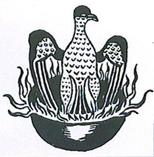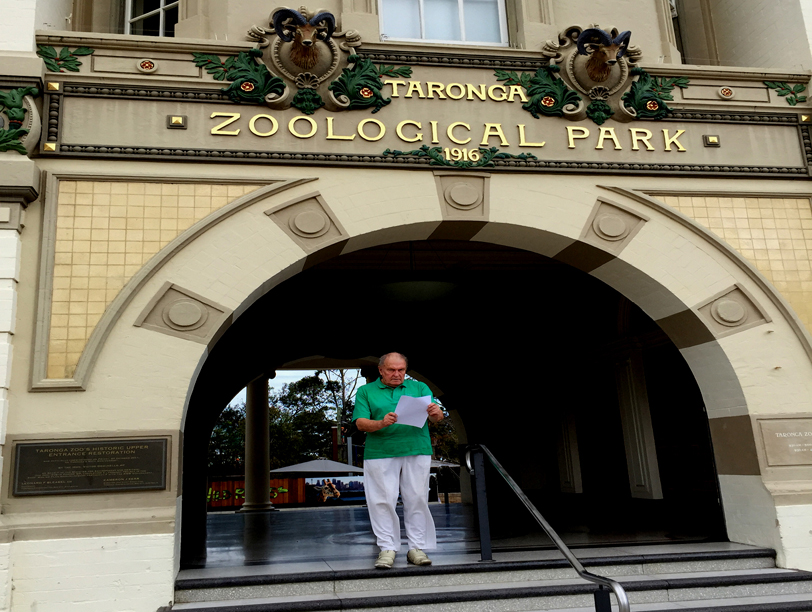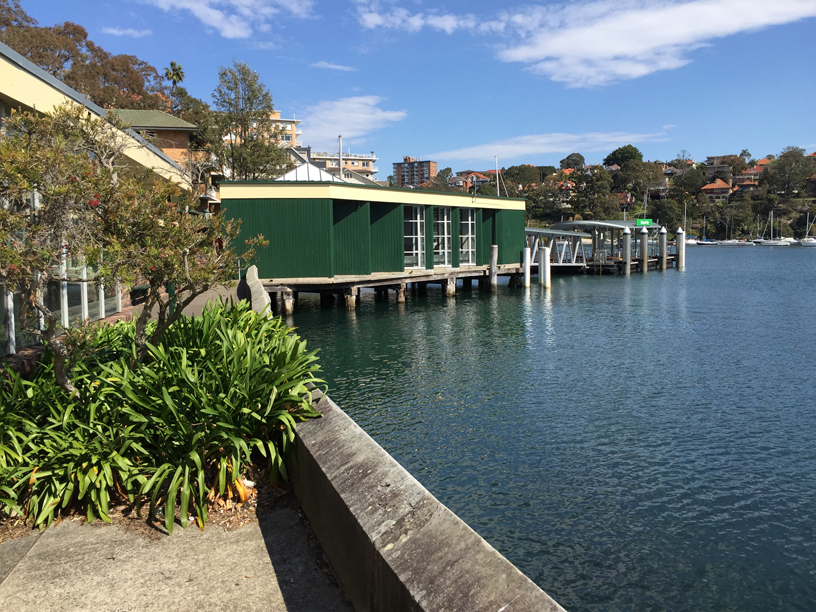 |
|
WHAT LAWRENCE DID AT THE ZOO

DHLA President, Robert Darroch, reading Lawtence's poem, "Kangaroo"
on the entrance steps at Taronga Pak Zoo
|
LAWRENCE left Australia on August 11, 1922, having spent precisely 100 days in Australia – mainly in Sydney and Thirroul, where he spent half that time composing his 8th major novel, Kangaroo.
Hitherto, our DH Lawrence Society of Australia (DHLA) has marked the arrival of Lawrence in Sydney on May 27, 1922, by holding an annual picnic-lunch in The Rose Garden Pavilion of the Royal Botanic Garden (which Lawrence knew).
Alas, the Garden authority is now charging for use of the Pavilion, so it was decided instead to celebrate Lawrence's departure from Sydney on August 11.
We met at Mosman Wharf on Saturday August 22, 2015, to retrace Lawrence's steps on one of his several visits to Mosman and its environs (what he called “the North Shore”).
For on Thursday June 1, 1922, (at about 10.30am that sunny early-winter morning) Lawrence alighted from the

Mosman Wharf today
Mosman ferry – from which minutes earlier he had observed a ferry collision on the Harbour - where he was met by Jack Scott, his main contact in Sydney while he was there (and who had suggested the wharf meeting on a drive back to Sydney from Narrabeen the previous Sunday). Then the two of them walked around the Bay to a bench where the Mosman Rowers Club now is.
Stepping off the Mosman ferry this Saturday was DHLA member Robert Whitelaw (who bears scant similarity to Lawrence), to be met at the wharf by DHLA President Rob Darroch, Secretary Sandra Darroch, and Society members Michael Lester and Peter Jones.
Then, guided by Rob Darroch, the group retraced Lawrence's footsteps around the bottom of Mosman Bay to the pathway down which Jack Scott had walked from his flat in nearby Wycombe Road, Neutral Bay, to rendezvous that morning with Lawrence (a path he and Lawrence were to walk down two days later on their way to Thirroul and Wyewurk).
|
|
We then had lunch at the Mosman Rowers, which now sits on the spot where Lawrence and Scott had their fateful discussion 93 years ago. Because the event was arranged at rather late notice, a number of DHLA members had sent apologies, regretting they could not join us, including Robert O’Neill, Garry and Rose Shead, Paul Delprat, Rob Douglass, Greg Baran, Clif Barker, Robin Archer, Roger and Kerie Hooke, and John Ruffels. Andrew Moore, Beverley Firth, and Jo and Arnold Vink were absent overseas. (The DHL Society in England sent their best wishes for our Day at the Zoo.)
.JPG)
Lawrence (& Scott) came this way
After lunch we repaired to Taronga Park Zoo where Rob read out Lawrence’s poem “Kangaroo” which Lawrence
later wrote about his visit to the Zoo (see story below about the recent brou-ha-ha in the UK).
Delicate mother kangaroo
Sitting up there rabbit-wise, but huge, plumb-weighted,
And lifting her beautiful slender face,
oh! so much more gently and finely-lined than a rabbit's, more than a hare's
Yet another memorable DHLA occasion.
(Robert Darroch's third book on Lawrence in Australia,
THE NIGHTMARE, Lawrence's 100 Days in Australia, will be published later this year by The Svengali Press.)
|
A DAY AT THE ZOO
by Robert Darroch (President, the DH Lawrence Society of Australia) rob@cybersydney.com.au
A BROU-HA-HA has broken out in England about Lawrence’s attitude to animals in general and zoos in particular.
It revolves around the DH Lawrence Heritage Centre at the University of Nottingham – one of the world’s main focal points of DH Lawrence studies and appreciation of Lawrence’s life and works.
The Centre is always struggling to keep its head above water, and recently it has hit upon a way of attracting visitors – particularly young visitors – to keep its turnstiles ticking over.
Some weeks ago it hosted a dog show at the Centre, with prizes for the best-looking dog and the waggiest tail.
DH Lawrence aficionados tut-tutted about this frankly down-market appeal for patronage, but bit their literary tongues.
Yet now, according to some Lawrence purists, the Centre has ventured too far down the populist road.
The Centre recently announced that the Bugs n Bones Travelling Exotic Petting Zoo would be making an appearance at the Centre in the near future.
This, for the a senior member of the DH Lawrence Society of Great Britain, David Brock, was a bridge too far, and he summarily resigned from all his posts in the Society (newsletter editor, speaker secretary and press officer) – in protest at what he described as “an affront to all that Lawrence stood for”.
“The centre is giving out the totally wrong message to visitors about Lawrence’s philosophy,” he said. “Lawrence would be livid at the lack of reverence for life shown by the centre in his name. A recurring theme of Lawrence’s writing was his deep connection with nature. Lawrence believed that animals are to be respected as individuals in their own right and are not for this kind of human exploitation.”
(A “petting zoo” is a sort of children’s zoo where small children can pat and touch its docile inhabitants, and who pose no danger to the young patrons. They are growing in popularity around the world, and are, in their mobile form, particularly popular at children’s parties.)
However, while Mr Brock may have been a pillar – and voice - of the UK Lawrence Society, he clearly had not read Lawrence’s 8th novel, Kangaroo. For in Lawrence’s 1923 Australian novel the main character – who is clearly Lawrence himself – visits Taronga Park Zoo in Sydney, and is much taken by its inmates.
…he went over to the Zoo, on the other side of the harbour--and the warm sun shone on the rocks and the mimosa bloom, and he saw the animals, the tenderness came back. A girl he had met, a steamer-acquaintance, had given him a packet of little extra-strong peppermint sweets. The animals liked them. The grizzly bear caught them and ate them with excitement, panting after the hotness of the strong peppermint, and opening his mouth wide, wide, for more. And one golden brown old-man kangaroo, with his great earth-cleaving tail and his little hanging hands, hopped up to the fence and lifted his sensitive nose quivering, and gently nibbled the sweet between Richard's fingers. So gently, so determinedly nibbled the sweet, but never hurting the fingers that held it. And looking up with the big, prominent Australian eyes, so aged in consciousness, with a fathomless, dark, fern-age gentleness and gloom. The female wouldn't come near to eat. She only sat up and watched, and her little one hung its tiny fawn's head and one long ear and one fore-leg out of her pouch, in the middle of her soft, big, grey body. Such a married couple! Two kangaroos. And the blood in Richard's veins all gone dark with a sort of sad tenderness. The gentle kangaroos, with their weight in heavy blood on the ground, in their great tail! It wasn't love he felt for them, but a dark, animal tenderness, and another sort of consciousness, deeper than human.
So much for Lawrence dislike of zoos.
In fact, so taken was Lawrence with the zoo that he wrote one of his best poems about his visit there. He called it “Kangaroo”:
Delicate mother Kangaroo
|
Sitting up there rabbit-wise, but huge, plumb-weighted,
|
And lifting her beautiful slender face,
oh! so much more gently and finely-lined than a rabbit’s, or than a hare’s
To mark Lawrence’s visit to Taronga Park Zoo in 1922, the DH Lawrence Society of Australia will hold “A Day at the Zoo” event on Saturday August 22.
(We normally hold our annual Lawrence picnic in the Botanic Garden in May, but this year we could not, partly because the Gardens authority has put, for us, a prohibitive charge on such functions. So we have decided to switch our commemorative event from the month he arrived in Sydney, to the month he departed.)
|
|
|
| If you wish to join the
DH Lawrence Society of Australia, it's free. Just send us your name
and email address. Click HERE |
|

